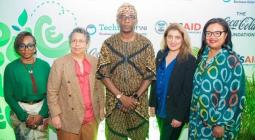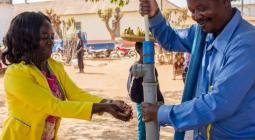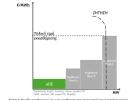Climate-Focused Foreign Aid Advances U.S. Interests Abroad, Outgoing USAID Official Says
Gillian Caldwell, who led humanitarian climate efforts during the Biden administration, argues that continued investment can address bipartisan concerns like migration.
In Bangladesh, some 500,000 people escaped harm from a powerful cyclone last year with the help of disaster warning and protection systems funded by the United States. In sub-Saharan Africa, meanwhile, some farmers saw 25 percent increases in crop yields despite multi-year drought, in part due to U.S. humanitarian aid.
Over the past four years, India has procured record levels of renewable energy through competitive bidding, community-led conservation groups have preserved rainforests in Vietnam and watershed restoration projects are tackling water scarcity in Honduras—all with the help of the U.S. Agency for International Development.
Under President Joe Biden’s administration, addressing climate change became an integral part of the mission of USAID—an agency created 63 years ago to advance the national interest by helping foreign countries in need. The agency is the world’s largest bilateral humanitarian and development aid agency, with a $27.6 billion budget and programs in 100 countries. In fiscal year 2024, USAID and U.S. Department of State funding on climate programs totaled $679 million, up 75 percent compared to the end of the first Trump administration. And USAID estimates that its investments have mobilized far more public and private climate finance—more than $30 billion—from 2021 through 2023.
But the future of USAID—and its goal of reducing global greenhouse gas emissions by 6 billion metric tons by 2030, the equivalent of erasing a full year of U.S. domestic emissions—is in jeopardy. President-elect Donald Trump has promised a retreat both from climate action and international engagement, and unlike in his first term, he has a team in place ready to fulfill that aim.
“Why are we doing this when our own country is so deeply in debt?” Elon Musk posted on his social media platform, X, earlier this month while sharing a graph showing that the United States is the world’s largest donor of international humanitarian aid. Musk has indicated that spending—less than 1 percent of the nation’s $6.7 trillion budget—will be a target of the new Department of Government Efficiency task force that he will co-chair. And Project 2025, the conservative policy roadmap created by Trump allies and appointees, calls for re-orienting USAID to “cease its war on fossil fuels” and support the tapping of oil and gas “as the quickest way to end wrenching poverty.”
With USAID facing a possible abrupt end to its climate work, Inside Climate News talked to Gillian Caldwell, who served as USAID’s chief climate officer during the Biden administration, about the case for continuing to help the developing world reduce reliance on fossil fuel and build climate resilience. She echoed warnings made by USAID Administrator Samantha Power, a former United Nations ambassador and author of a Pulitzer Prize-winning book on genocide, that climate change could undermine all other investments the United States has made in addressing poverty.
The conversation has been edited for length and clarity.
MARIANNE LAVELLE: Can you talk about why addressing climate change in developing countries fits within USAID’s purpose to promote U.S. interests abroad?
GILLIAN CALDWELL: It’s in the U.S.’ best interest to ensure stable, prosperous countries around the world. If you don’t have a stable and prosperous economy, you create a breeding ground for terrorism and you increase the likelihood of climate-related migration. Of course, that’s a real concern to politicians on both sides of the aisle.
It’s also incredibly important to recognize that we have an unprecedented transition underway because of the falling price of renewable energy. Our partner countries are demanding renewable energy for addressing energy poverty and trying to bring their own communities online. And if we want to remain competitive in economic terms, in a global economy where [the People’s Republic of China] and other malign actors are really dominating the field of industrialization and clean energy, we absolutely need to engage here.
And finally, there’s just efficiency and effectiveness to be had. We can’t constantly be in a reactive mode, sort of lurching from one disaster to the next. We need to think about investments that will reduce the price tag over time, and increase the resilience of the infrastructure that we know is going to face unprecedented shocks and stressors in the years to come.
LAVELLE: One of the things that USAID has done is promote renewable energy auctions in countries. Can you talk about that work?
CALDWELL: Our work in delivering modern energy services has improved electricity access in more than 40 countries globally. We don’t typically procure solar panels—we do understand there have been concerns expressed, again on both sides of the aisle, regarding the procurement of panels, which may have been tainted by forced labor in Xinjiang [in China].
Our focus is on these renewable energy auctions because we’re creating a level playing field for foreign direct investment, and ensuring clear and transparent auctions in which American energy companies and American investors can compete. We won’t see the same kind of graft that we might see in other contexts where cash passes hands to secure contracts behind the scenes. We’ve seen many, many U.S. companies step into that opportunity. And of course, the countries that we’re supporting are getting the benefit of predictable, affordable, competitive prices over time for bringing that energy online.
LAVELLE: There’s an argument made sometimes on Capitol Hill that the goals of addressing climate are in conflict with other USAID goals. [House Foreign Affairs Committee Chairman Michael McCaul (R-Texas) took the agency to task at a hearing last year for, in his view, prioritizing cutting carbon over addressing the threat of China.] How do you respond to that sort of argument?
CALDWELL: Well, I don’t think it makes sense, because I absolutely agree we need to be competitive with China. And if you look at China’s investments in Africa, a large majority relate to locking down the critical mineral supply chain, in places like the [Democratic Republic of the Congo]. The U.S. has ceded far too much terrain, in my view, when it comes to cobalt and lithium and nickel and copper and the many other critical minerals necessary to power the clean energy transition. It’s a question of energy security and national security to make sure we have access to those minerals so that we can stimulate and support our own economic development and our own opportunity in the renewable energy economy of the future.
The [People’s Republic of China] should not be the partner of choice for the infrastructural investments that Africa needs. We see far too many African countries indebted to the PRC, and unfortunately, a lot of the infrastructural work that’s being done isn’t up to standards, and has not got the kind of resilience that we need to see in order to ensure sustainability, when extreme weather events are going to put additional stresses on infrastructure.
So it’s not mutually exclusive. Yes, we need to remain competitive with China. And China understands, as we should, that the renewable energy space is one of the most important terrains in which to operate right now, and there are demands and needs for financial support to build the infrastructure of the future.
LAVELLE: What else would you like to highlight about what USAID has done on climate over the last four years?
CALDWELL: We’re working with partners in more than 50 countries to conserve and restore more than 200 million acres of land and forest. That’s an area twice the size of California, and that landscape is critical both to keeping global temperatures [stable] and to supporting the biodiversity that our bipartisan friends in Congress and all around the world have come to expect in places like the Amazon rainforest, the Congo Basin and in Southeast Asia.
We’re doing that at the price of about $2 per football field of forest, and we’re leveraging between $2 and $10 to $15 from our supporting partners for every U.S. dollar spent. So we take that public trust very seriously. We need to keep challenging ourselves—as we have been—to be as efficient and as effective as possible in our investments.
LAVELLE: The private sector works with USAID. Could they be doing this work on their own, without U.S. government involvement?
CALDWELL: Well, in many cases, they’re looking for that concessional finance to get them over the hump. There’s some upfront risk capital necessary, especially given the kinds of areas in which we work, which are fragile or affected by conflict, or economies that have some instability. So the concessional capital can be really powerful.
Through our clean energy work and our forest conservation work combined, we helped avoid nearly 380 million metric tons of greenhouse gas emissions in the past three years, and we’re projecting reductions of a further 1.3 billion metric tons in future emissions. That combined amount is equal to all U.S. power sector emissions in a year.
Since 2021, we’ve increased the number of countries in which we’re working to tackle the climate crisis from 45 to over 100, and much of that growth was in adaptation and resilience. Our administrator, Samantha Power, says this is what she hears first and foremost when she’s on the road: “Help us survive the onslaught. We don’t want to be dependent on your aid. We want the resources to be able to navigate this independently.”
Cover photo: USAID helps farmers in Villa de San Francisco, Francisco Morazán, Honduras, adopt climate-smart technologies. Credit: Andre Ancheta for USAID




